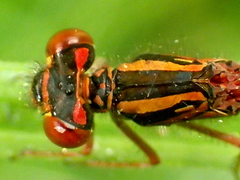Red Damselfly
Xanthocnemis zealandicaSummary 8
Xanthocnemis zealandica, commonly known as red damsefly or red coat damselfly is the most common native New Zealand damselfly. Adult damselfies are often seen flying around vegetation close to streams.
Description - adults 9
Males and females are 30 to 35mm long, with yellow-orange legs.
Males have a red abdomen with black markings - the first segment has a black spot on it, the last segments have a black stripe on their sides. Thorax is black with orange-red side patches. Eyes widely separated and red in colour.
As with most damselflies there is a downward bulge in segment two (the first segment fully visible after the thorax) of a male, and the abdomen narrows then widens again towards the tail. The claspers on the end of the tail are less obvious than in the male NZ Blue Damselfly.
Example of a male thorax (top view and side view) :
Example of the end of a male abdomen (top view and side view) :
Females are described as having two colour morphs
1) Androchrome (=similar to male colours) abdomen more orange/brown than red, similar markings to the males, just not as bright. More complex and extensive black markings than male. Thorax black with yellow-buff instead of orange-red. Eyes brown.
2) Heterochrome (=not the same as the male) abdomen upper surface black-bronze (can look irredescent green in strong light), fading to yellowish or grayish on the sides and underside. Also narrow cream rings around the ends of each abdomen segment. Eyes brown.
The last three segments of the female abdomen (top view and side view) :
Differences from Austrolestes species: about 10mm shorter and the colour of the pterostigma (spot on the wing) is red compared to the Austrolestes brown/black spot.
Emergence is between August and March, though the largest numbers of adults are abroad from November to March.
Description - nymphs 9
They have a wider/shorter bodies than blue damselflies and do not have the hard defined stripes seperating each tail segment.
When swimming red damselflies waggle dramatically side to side whereas blue damselflies are more streamlined swimmers which dart around everywhere when disturbed.
References 9
The dragonflies of New Zealand by Rowe, R.J. [contributions by Corbet, P.S. ; Winstanley, W.J.] 1987. PDF
Identification notes left by Tanya Dann in comments on NatureWatch, and descriptions from her interview on radionz: damselflies-fast-blue-and-slow-red.
Sources and Credits
- (c) Tony Wills, some rights reserved (CC BY-SA), uploaded by Tony Wills
- (c) Jon Sullivan, some rights reserved (CC BY), uploaded by Jon Sullivan
- (c) Auckland War Memorial Museum, some rights reserved (CC BY), http://commons.wikimedia.org/wiki/File:Xanthocnemis_zealandica_AMNZ5080_male2.jpg
- (c) Jon Sullivan, some rights reserved (CC BY), http://www.flickr.com/photos/16921893@N00/8185910644
- (c) Peter Shearer, some rights reserved (CC BY-NC), uploaded by Peter Shearer
- (c) John Wattie, some rights reserved (CC BY-NC-SA), https://www.flickr.com/photos/kiwizone/8502653194/
- (c) Kate McCombs, some rights reserved (CC BY-NC), uploaded by Kate McCombs
- Adapted by Tony Wills from a work by (c) Wikipedia, some rights reserved (CC BY-SA), http://en.wikipedia.org/wiki/Xanthocnemis_zealandica
- (c) Tony Wills, some rights reserved (CC BY-SA)



















